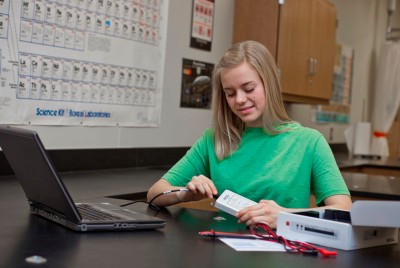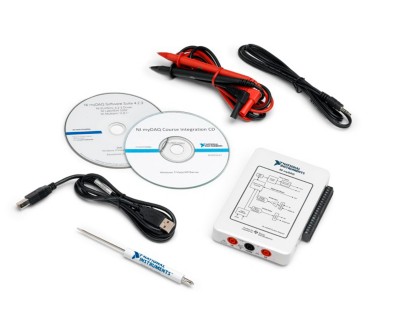University of Leeds Teaches First-Year Engineering Students With LabVIEW and NI myDAQ
Martin Levesley, University of Leeds, School of Mechanical Engineering

"The module has about 160 students so we needed a solution that was cost-effective and easily deployable in standard computer clusters. When we discovered NI myDAQ through the NI academic team, this instantly ticked all of the boxes."
- Martin Levesley, University of Leeds, School of Mechanical Engineering
The Challenge:
Empowering first-year mechanical engineering and product design students with industry-relevant hardware and software skills that lead them to success as undergraduates and improve their post-graduation employability.
The Solution:
Developing an exercise-driven approach to teaching students to use NI LabVIEW system design software and integrating NI myDAQ hardware to engage students and demonstrate the real-world benefits of graphical system design before teaching the underlying programming concepts.
Author(s):
Peter Culmer - University of Leeds, School of Mechanical Engineering
Martin Levesley - University of Leeds, School of Mechanical Engineering
The University of Leeds mechanical engineering and product design courses include the first-year undergraduate modules “Computing and Analytical Skills” and “Fundamentals of Functional Prototypes,” respectively. In these courses, students gain practical hardware and software skills that they can take advantage of throughout their education and into industry.

Mechanical Engineering: Computing and Analytical Skills
The School of Mechanical Engineering has an international reputation for teaching and research and is one of the leading mechanical engineering departments in the United Kingdom. The high standard of our research feeds directly into undergraduate curriculum design, ensuring our graduates are equipped with the most up-to-date techniques, methods, and knowledge bases. Our teaching is orientated to the expressed needs of industry.
Originally a software-only module, “Computing and Analytical Skills” focused on script-based programming languages and statistics. Many students found this difficult to relate to and relayed this in their feedback. From here, we moved to adding the LabVIEW software platform to the traditional text-based approaches. Student feedback consistently praised the graphical approach and intuitive user interface. The department quickly took this onboard and looked to further engage students by incorporating a hardware element.
We were looking for hardware that could excite the students with a hands-on approach. The module has about 160 students so we needed a solution that was cost-effective and easily deployable in standard computer clusters. When we discovered NI myDAQ hardware through the NI academic team, this instantly ticked all of the boxes.
NI myDAQ is a powerful and flexible student-centric measurement device. It was ideal because of its portability and USB interface that allowed us to take our lab to the cluster. We taught students how to configure NI myDAQ as a digital multimeter (DMM) and connect it to their PCs. This was possible through the built-in NI ELVISmx drivers that enabled NI myDAQ to be used as a PC-based oscilloscope, DMM, and function generator straight out of the box. This is transferable into other modules, particularly during coursework and students’ own external projects.
From here, we revamped the module with a “show-then-teach” concept in LabVIEW. We began each class with an exciting and relevant example of what is possible with LabVIEW and measurement hardware. These included measuring gravity fields and interfacing with the Kinect for Xbox 360. This had a powerful effect on students who were intrigued by the examples and wanted to learn the skills that made it possible. This is a big contrast to the older module where we attempted (with our best effort) to convince students of the usefulness of software tools. To further compound the effect, we tied in these fun examples with real-world industrial and research applications showing what can be achieved on a larger scale.
The University of Leeds is at the forefront of researching the solutions to important challenges of the twenty-first century, and LabVIEW has played a large role in making this possible. We are keen for this to be initiated early on with our undergraduates and are now reaping the rewards.

Product Design: Fundamentals of Functional Prototypes
We developed our innovative multidisciplinary degree course in product design to produce skilled, creative designers who understand both aesthetics and technology, which are key attributes identified by many leading employers in the sector. It bridges the gap between visual arts-led and engineering-led product design courses and gives Leeds graduates a significant advantage by equipping them with a wider variety of employment opportunities.
Product design students often lack a typical engineering background consisting of A-level mathematics and physics, but it is crucial that they become familiar with electronics. In product design, it is important for students to understand how a product functions to appreciate how their design comes to life and foresee possible constraints in the manufacturing process. Fundamentally, we wanted to develop students with the skills necessary to create professional working prototypes rather than just a shell for a product, which looks nice and in theory is designed well. We completely revamped the module two years ago to include LabVIEW and NI myDAQ.
In the previous approach, students often used text-based peripheral interface controller (PIC) hardware and programming they found difficult to understand and felt restricted the scale of what they could implement. Often, students would opt to create a simple “shell” prototype that had little working functionality.
The impact of the National Instruments platform on the standard of undergraduate product design projects is incredible. Students create complex prototypes that use many different modern technologies. Design students appreciate the graphical nature of LabVIEW and can program in a similar manner to how they think of their designs on paper. Additionally, the seamless integration with hardware enabled the students to easily interact with real-world signals using NI myDAQ and they can even communicate wirelessly with a tablet computer using LabVIEW.

The Impact: Student Satisfaction and an Ecosystem
We are now teaching undergraduate engineers hardware, electronics, and measurement skills that are transferable to future modules and into industry. Alongside this core objective, a dramatic transformation in module feedback occurred as well. The overall approval rating increased from 14 percent to 89 percent—undoubtedly, NI myDAQ was a significant influence.
Due to the intuitive graphical system design approach, we are not restricted to only a handful of experts who understand LabVIEW and the NI myDAQ platform. We can gain input from students and staff from all disciplines on how to improve the modules. Students also have much more support than was possible with PIC hardware or equivalent systems.
Students have even created their own LabVIEW support network and user groups through web-based social media. This was certainly an unexpected benefit but very welcome and encouraged by the university.
NI Support
The university took advantage of the NI Academic Site License program, now referred to as an Academic Volume License. This handled the administration of software not only to the labs but can also license the students’ home PCs with the student install option. If students are getting very involved in the module, which is increasingly becoming the case, more and more requests come in from those who want to carry on their learning away from the lab. The Academic Volume License handles this easily with minimal interaction from our IT department.
With academically discounted training courses, more of us could learn the best possible programming practices, which could then be transferred to the students. We have a strong ethos at the University of Leeds for preparing undergraduate engineers for industry and believed it was necessary to learn from the best NI engineers ourselves before passing on these skills. This also helped us improve our productivity in creating new engaging exercises and course materials.
Overall, we benefitted from amazing interaction and involvement with the NI academic team. They guided us through every step of the curriculum reform and their engineers were on hand with fantastic technical support.
Author Information:
Peter Culmer
University of Leeds, School of Mechanical Engineering
University of Leeds, School of Mechanical Engineering,
Leeds LS2 9JT
United Kingdom
p.r.culmer@leeds.ac.uk